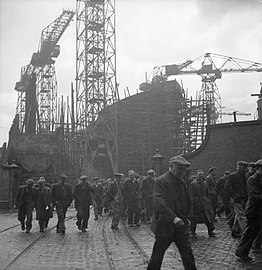
| History of Scotland |
|---|
 |
|
|
The economic history of Scotland charts economic development in the history of Scotland from earliest times, through seven centuries as an independent state and following Union with England, three centuries as a country of the United Kingdom. Before 1700 Scotland was a poor rural area, with few natural resources or advantages, remotely located on the periphery of the European world. Outward migration to England, and to North America, was heavy from 1700 well into the 20th century. After 1800 the economy took off, and industrialized rapidly, with textile, coal, iron, railroads, and most famously shipbuilding and banking. Glasgow was the centre of the Scottish economy. After the end of the First World War in 1918, Scotland went into a steady economic decline, shedding thousands of high-paying engineering jobs, and having very high rates of unemployment especially in the 1930s. Wartime demand in the Second World War temporarily reversed the decline, but conditions were difficult in the 1950s and 1960s. The discovery of North Sea oil in the 1970s brought new wealth, and a new cycle of boom and bust, even as the old industrial base had decayed.[1][2]
© MMXXIII Rich X Search. We shall prevail. All rights reserved. Rich X Search
